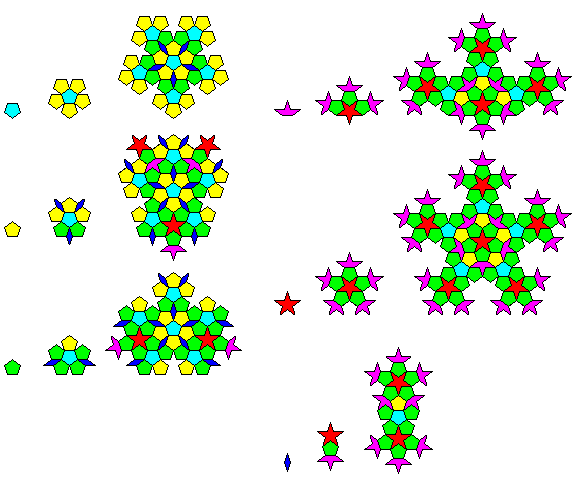
The Penrose tiling based on the kite and dart pieces is very closely related to the type of Keplerian tiling shown on the previous page, as we will see shortly.
Here is an illustration of an attempt I made to form a Penrose tiling from kites and darts:
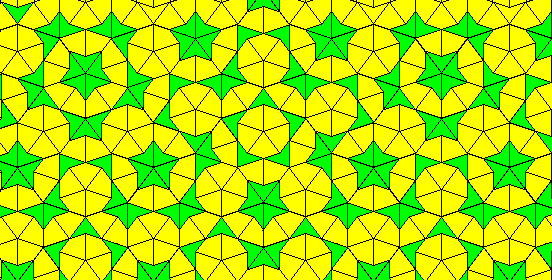
This diagram shows the basic facts about this Penrose tiling; two tiles with colors on them illustrating the matching rules, and a segment of a Penrose tiling showing the recurrence relation:

Since the darts are split in half by the recurrence, the type of recurrence relation used by these shapes can be somewhat confusing.
Here are a kite and dart on a larger scale, built from pentagons and stars and decagons:
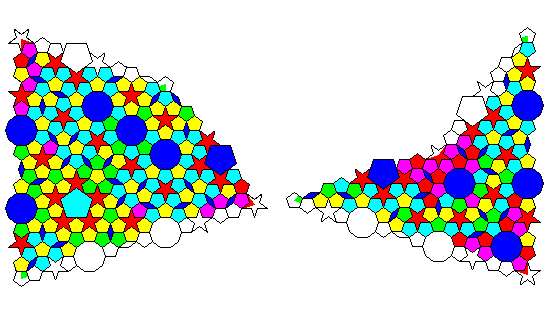
In this diagram, uncolored shapes are to be covered by colored ones; the joining rules that ensure the tiling created is aperiodic can be seen within this diagram.
Note that decagons, along with double-sized pentagons, both of which, like the pentagon, have five-fold symmetry themselves, are used in the pentagonal tiling from which these pieces are made, which does not itself follow the Penrose rules, in such a way as to completely eliminate the "boat" piece, which does not have five-fold symmetry. The diamond piece remains, as it seems to be completely unavoidable.
Here, with the kites and darts colored in solid colors, to bring out the symmetries of the pattern,
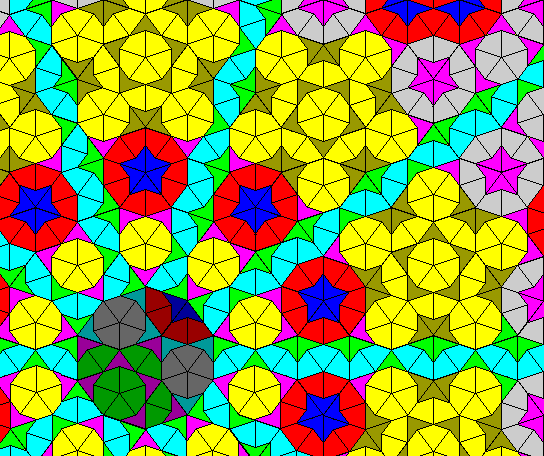
is a detail from the infinite cartwheel pattern.
(More specifically, it is a detail near the center of the infinite cartwheel pattern: it is also, of course, a detail from some location within any Penrose tiling of the kite and dart type; just as, between the spokes of this pattern, one sees larger and larger segments of the parts of the sun and star patterns about their centers, one can find any finite portion of one pattern within any other; thus, only in their infinite overall scheme are there different kite and dart Penrose tilings.)
The area in darker colors is the center of the pattern, a decagon that John H. Conway named the "cartwheel". Every kite and every dart in any Penrose tiling built from kites and darts is part of a cartwheel in some orientation. (This Penrose tiling has a number of other fascinating properties; rather than attempting to discuss them all here, I would refer readers to the January, 1977 column by Martin Gardner in Scientific American, and to numerous other web sites that cover these beautiful tilings in more detail.) This particular pattern has a symmetry which the colors attempt to reveal which is similar to that of some parts of the Mandelbrot set: in addition to ten rays proceeding from the center, colored in two shades of green, the spaces between the rays are filled with larger and larger patterns with pentagonal symmetry of two basic types; one illustrated in yellow and brown, and the other illustrated in red and blue.
When I originally drew the diagram above, I had made a mistake in the orientations of some of the ten rays of wide and narrow bow-ties from the center. This resulted in what was actually one of the arrangements created by what is known as a decapod:
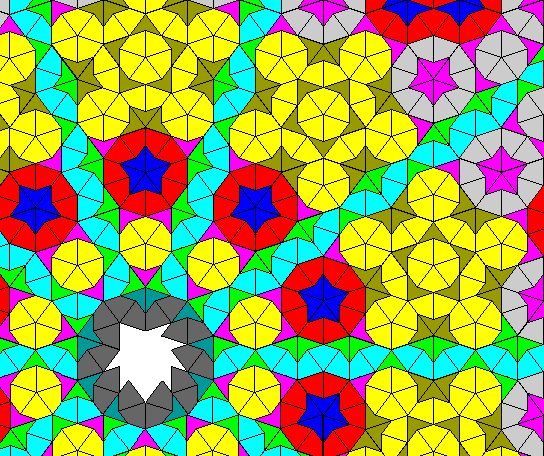
There are 62 possible arrangements of ten shallow triangles called decapods. Only one can be constructed from the kite and dart tiles, and forms the center of a cartwheel. Another can form a shape equivalent to a cartwheel. The other sixty imperfections all force only one unique tiling to infinity, unlike shapes that belong to true Penrose tilings, and that tiling is a modified infinite cartwheel pattern with some of the rays reversed.
It is also possible to produce a Penrose tiling from two shapes even simpler than kites and darts, two symmetrical rhombuses of different shape, and here is an example of such a tiling:
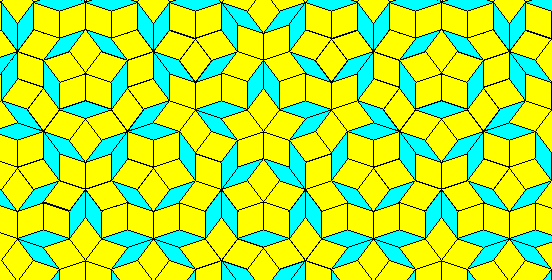
And here is a further example of a small part of such a tiling:
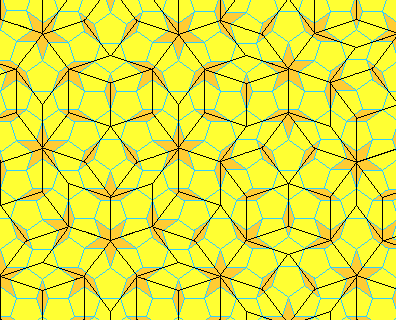
Note the stars, boats, and pentagons in the background. This illustrates the fact that there is a relationship between the Penrose rhomb tiling and pentagonal tilings. A similar background in a diagram of the kite and dart tiling:
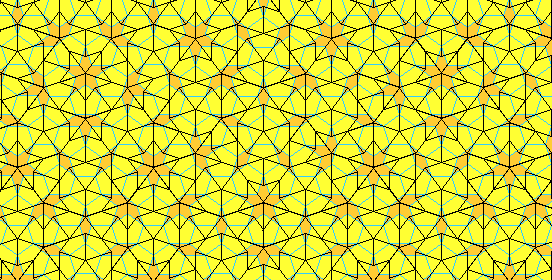
not only illustrates this as well, but in this latter case (not in the case of the rhomb tiling) it turns out that the background shapes are organized according to the original Penrose tiling, despite the fact that they were originally present primarily to make the kite and dart shapes easier to draw, but also to illustrate the relationship to pentagonal tilings in general.
It should be noted that the shapes in the background of the rhomb tiling are arranged with the symmetry of a Penrose tiling, and hence a Penrose tiling corresponding to their arrangement could likely be developed.
One of the most fascinating properties of the Penrose tiling is that any finite portion of a Penrose tiling based on one set of pieces will be present an infinite number of times in both that tiling, and in any other tiling using those pieces. Despite the fact that the number of possible Penrose tilings with a given set of pieces is not only infinite, but uncountable, from the finite point of view, it seems as if there is only one possible Penrose tiling.
In addition, the maximum distance from a pattern to its reappearance can be determined based on the size of that pattern, and is a fairly low multiple of the size of the pattern.
In a true Keplerian tiling, formed by strict application of a recurrence relation, the property that any part of the pattern will reappear an infinite number of times is usually also present, since any pattern would have a location somewhere inside one of the basic tiles of the pattern as a parent piece. But unlike the Penrose tiling, it can happen that the distance to a reappearance of a pattern depends strongly on which part of the overall pattern it belongs to, and it can be immensely far away.
The octagonal tiling below illustrates, however, how a Keplerian tiling can fail to have this property. If one particular series of piece types only occurs once as the result of successive iterations of the recurrence relation being applied to a piece type on that series, then one can have a pattern in which a particular arrangement of pieces occurs only once in the center. The rule for overlapping octagons in that tiling was modified so that this would not happen there.
Although this begins to enter into heavily mathematical territory beyond the scope of this page, the following diagram illustrates Ammann bars, which bring out a hidden long-range symmetry of the Penrose kite and dart tiling (they are also applicable to many other tilings):
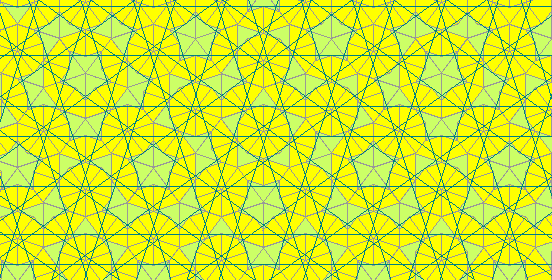
The distances between these lines are in the golden ratio to each other, as might be expected in a tiling with pentagonal symmetry, and the pattern of long and short gaps must be a part of the infinite sequence produced by applying the rules
L becomes LS S becomes L
to be applied to every gap mentioned in each generation, over an infinite number of generations...
S L L S L S L L S L L S L SL L SL SL LSLLSLSLLSLLS
producing what are known as "musical sequences".
The following diagram:
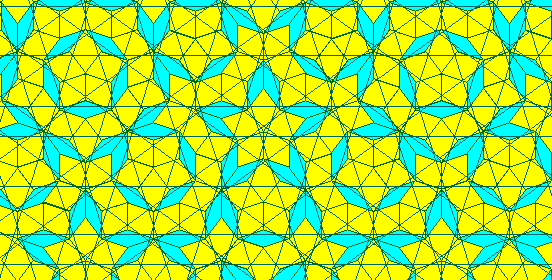
shows the Ammann bars for the Penrose tiling of rhombuses, and so does this additional diagram:
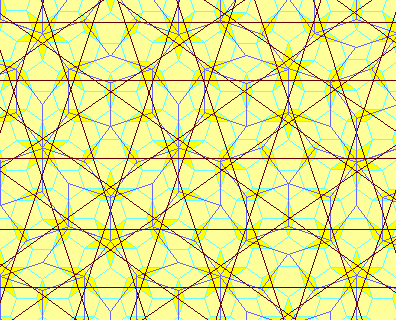
Note that the spacing of the Ammann bars in the second diagram is different for that of the kite and dart tiling, despite the fact that pentagons and stars appear in these two diagrams on the same scale. This shows that the trivial isomorphism between the rhombs and the kite and dart which the pentagons and stars in the background suggest is not the real isomorphism between the two types of tilings, which instead becomes apparent at a different relative scale. Their real relationship is shown in the diagram below:
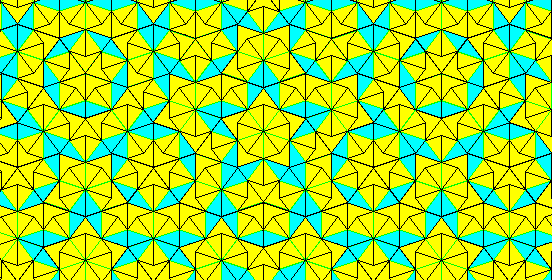
Since there exist recurrence relations for both the kite and dart pair and the pair of rhombi, of course, relationships at some other relative scales are possible.
The first aperiodic tiling devised by Dr. Roger Penrose, which used six types of tiles, is even more closely related to the type of Keplerian tiling featured on this page, and these tiles can easily be expressed in a form built from the pentagon, the star, and the boat, which shapes they themselves resemble:
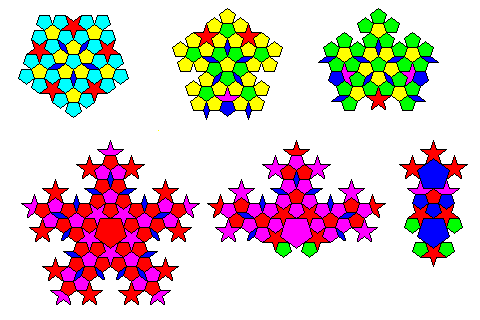
The pentagons, stars, and boats inside the shapes are arranged simply to form appropriate shapes, following the rules of a Kepler tiling, not those of the Penrose tiling the shapes they make up can form. The actual recurrence relations in the six-tile Penrose tiling itself are shown in the diagram below:

Note that even the largest shapes in the diagram cannot simply be tiled according to how they can fit, but instead, the colors of the elementary shapes, indicating that the edges follow the rules which follow from the shapes of the edges of the pieces in the preceding diagram must be applied. But the second-order recurrence relation does have an advantage over the first-order recurrence relation shown, in that it is a true recurrence relation: in the first-order one, the orientation of the diamond piece is not specified.
And here is an example of this type of Penrose tiling, with the tiles colored so as to make the recurrence relation visible:
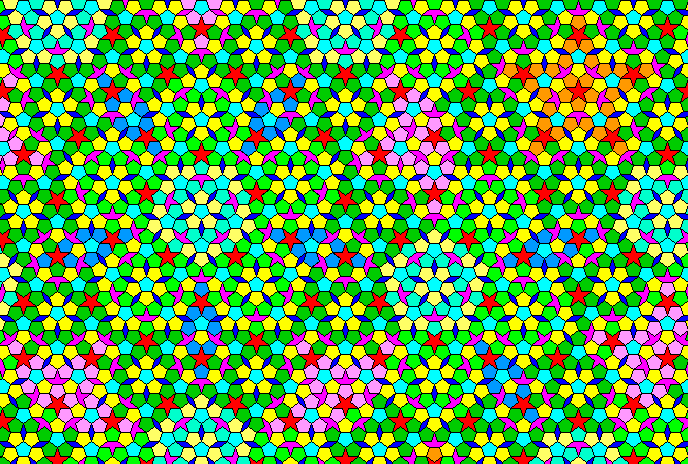
It turns out that the kite and dart Penrose tiling relates to this original Penrose tiling by precisely the relationship between kites and darts and pentagons, stars, and boats used in the first diagram of the kite and dart tiling above, as this diagram shows:
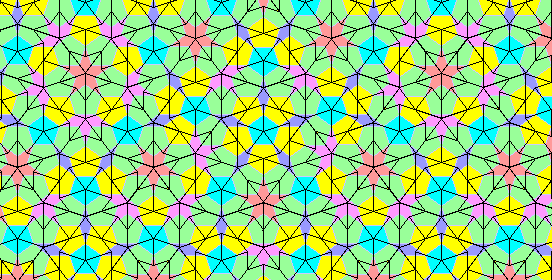
Their relation to the rhombi is shown in this diagram:
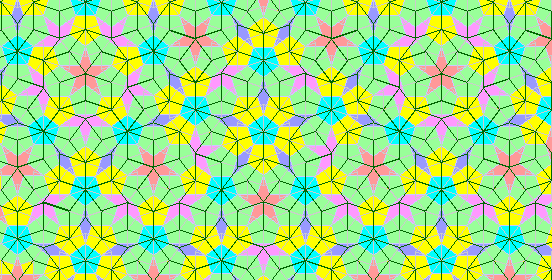
and the relationship between Ammann bars and this version of the Penrose tiling is shown here,
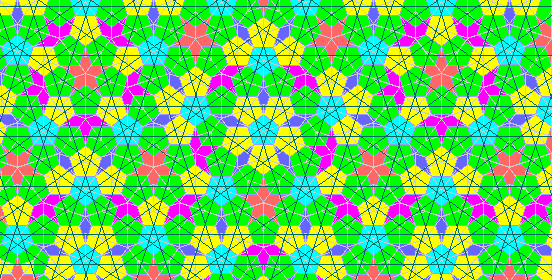
Note that the Ammann bars cross the sides of the pentagons and other shapes through their exact midpoints; also, their directions are the same as those of the sides of these shapes, while they are at right angles to the sides of the kites, darts, and rhombi.
Incidentally, the drawing of a large segment of the original Penrose tiling is a detail from near the center of the one corresponding to the infinite Sun kite and dart tiling.
As noted above, I have not gone very far here in examining the many fascinating mathematical properties of the Penrose tilings. But I will examine one of them now. In the kite and dart version of the Penrose tiling, the ratio of kites to darts, as the area approaches infinity, is phi, the golden ratio, which is (1 + sqrt(5))/2. This number can be found in the pentagon, and in aspects of the shapes of the kites and darts themselves as well. Also, the different possible combinations of kites and darts around the vertices of these shapes are seven in number, and have been named Sun, Star, Ace, Deuce, Jack, Queen, and King. These shapes are illustrated elsewhere, but it will be possible to see what they are by looking at the diagram of the relationship of the original six-tile Penrose tiling to the kite and dart tiling above.
In an attempt to find the limit frequencies of the six original Penrose tiles from the properties of the kite and dart tiling, the first thing one might note is that the diamond is always found in the middle of a dart. But sometimes darts will combine to form the boat or star pieces.
Each star piece has a Star vertex of the kite and dart pattern in the center, and is furthermore surrounded by five pentagons of the matching type indicated in the diagram by a green color. The opposite side of the five darts pointing into it is furthermore the center of an Ace vertex; this vertex type occurs in other relationships to the original Penrose tiling as well. And the points of the Star vertex pattern are themselves Deuce vertexes, and these too occur under other circumstances.
Each pentagon of the type indicated in the diagram by a blue-green color has a Sun vertex of the kite and dart pattern in its center.
The boat piece is invariably surrounded by three green pentagons (often shared with star pieces), and the boat's bottom is near the center of the King vertex. (Note that diagrams of the vertex types which have an error in the layout of pieces around the King vertex, showing the kites positioned in a way that violates the tiling rules, have been reproduced in some places. The names of the vertex types are due to the mathematician J. H. Conway, also responsible for the game of Life. No, not that game of Life; the cellular automaton one.)
Each pentagon of the type indicated in the diagram by a yellow color has a Jack vertex at its center.
The diamond piece always has one end near a Queen vertex, the other end is similarly near an Ace vertex, but that end could be replaced, in the Ace vertex, by the points of a star piece or a boat piece. It is the Queen vertex at the other end that ensures that a diamond will stay isolated instead of becoming part of a star or boat piece.
The pentagons indicated by a green color are also invariably associated with one vertex type, the Deuce vertex type.
Thus, we have one diamond per Queen vertex, one boat per King vertex, and one star per Star vertex; one blue-green pentagon per Sun vertex, one yellow pentagon per Jack vertex, and one green pentagon per Deuce vertex. Only the Ace vertex does not specifically correspond to any shape in the original Penrose tiling; one of these is associated with each point of a boat or star, and with the point of a diamond opposite the Queen vertex.
Hence, given the ratios of the vertex types in the kite and dart tiling, one also immediately knows the ratios of shapes in the original Penrose tiling, and the reverse is true as well.
The recurrence relations in the original Penrose tiling can be used to obtain these ratios. Let A stand for the number of blue-green pentagons, B the number of yellow pentagons, C the number of green pentagons, D the number of boats, E the number of stars, and F the number of diamonds, then these numbers are modified by one generation of recurrence as shown below:
A B C D E F
-----------------------
A 1 5
B 1 3 2 3
C 1 1 4 2
D 3 3 1
E 5 5 1
F 1 1 1
then, these recurrences in action, starting from a single blue-green pentagon, would produce the following numbers of tiles:
A 1 1 6 36 231 1586 11156 562886 B 5 20 100 575 3660 24280 1226260 C 10 95 780 5910 43165 2216730 D 15 200 1640 12205 628560 E 15 110 800 5725 289560 F 15 80 490 3285 22800 1140895
and one can repeat the recurrence to obtain the limiting ratios numerically: A=1, B=2.17288, C=3.94273, D=1.115611, E=.5134249, F=2.024296.
Just as the fact that the ratio of kites to darts is the golden ratio, I had expected the ratio between tiles in the original Penrose tiling, or the closely related ratio between vertex types in the kite and dart tiling, to be a commonly quoted result. By dint of an extensive Google search, I finally found this page which gives the answer, but for the eight vertex types of the rhomb tiling.
Thus, the diagram below
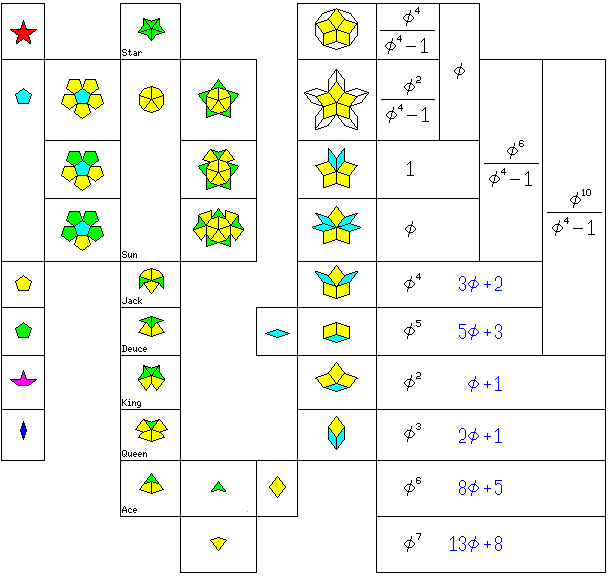
shows the frequencies of the tiles in the original Penrose tiling, the vertex types of the kite and dart Penrose tiling, and the vertex types of the rhomb Penrose tiling, as all are closely related. I have taken the powers of the golden ratio, and converted them to lower terms; as one may suspect, the coefficients are consecutive terms in the Fibonacci sequence,
1 1 2 3 5 8 13 21 34 55 89 144...
as a consequence of the fact that (1/phi) + 1 equals phi.
I feared that there may be an error somewhere, as the frequency of the Ace vertex type in the kite and dart tiling should be the same as the frequency of the thick rhomb, and that is given as phi^6; yet, when I take five times the frequency of the star, plus three times the frequency of the boat, plus the frequency of the diamond, which should also be that of the Ace, I get (47 * phi + 29)/(phi^4 - 1), which can be reduced to the value of (phi^9 + phi^7)/(phi^4 - 1); but if one divides the top by phi^6, to get phi^3 + phi, one gets 3 * phi + 1, and that exactly equals phi^4 - 1, which, for some reason, I was unable to see for some time; also, the frequencies here do not match the ones I obtained numerically (even, of course, after suitable scaling), and I am still unable to locate the error in that computation.
Two of the many other web sites that might be of interest are:
This site belongs to the web page of the same professor whose page on Archimedian solids I recommended as a much better page than my own;
and this site is one giving Penrose's original six-tile set.
This site is also a very good site on the Penrose tilings, giving much of the information in one place.